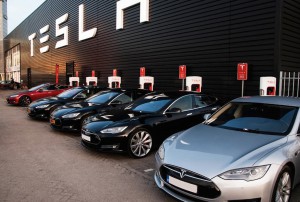
Consumer Reports had difficulty testing Tesla's new Model S P85 D because the door handles didn't work.
Consumer Reports, the influential non-profit publication that once called the Tesla Model S the best vehicle it ever tested, had harsher words for the latest – and fastest – version of the battery-electric sedan.
The $127,000 vehicle turned out to be “undriveable,” the magazine said in a new blog post because of problems with the automatic door handles that are supposed to extend out when someone with the keys approaches the vehicle, didn’t work. It’s an issue that others have been complaining about.
A new car shouldn’t have problems when you’ve owned it for less than a month,” the magazine said in its posting. “Yet Consumer Reports’ brand-new $127,000 Tesla Model S P85 D, with the fancy retractable door handles refused to let us in, effectively rendering the car undriveable.”
After repeatedly failing to get the driver door to operate, a CR tester was able to pop open the passenger door using a special smartphone app, crawl inside and over the center console and fire the Model S up. But only for two minutes. Sensing a problem, the car’s sophisticated electronics limited the amount of time the vehicle could be driven.
In the end, the magazine had to call Tesla for help and the start-up automaker sent a flatbed truck out to pick the vehicle up and take it to a dealer for repairs. On the positive side, CR reviewers said they were pleased with the way the service problem was handled. But that’s unlikely to overcome the fact that the car had issues in the first place.
Tesla has had its ups-and-downs in the eyes of Consumer Reports. The magazine initially gave the first Model S it tested the highest rating ever. But last year it issued a cautionary note, reporting that a survey of owners found that the car suffered from a number of glitches, especially with doors and latches. The magazine said its own Model S had “more than its share of problems.”
Even so, Consumer Reports continued to give the Model S a strong recommendation, something likely to resonate with potential buyers considering the demographics of the magazine’s readers.
(Tesla loses money in Q1, Model X coming in Q3. For more, Click Here.)
Like many cars on the road, the Model S is equipped with a proximity sensor that can detect when someone carrying its keys comes close to the vehicle. In the case of the Tesla, that triggers the vehicle to pop out hidden handles normally tucked away to help improve its aerodynamics. If that doesn’t happen a driver can be locked out.
There is a smartphone app to get into the vehicle but it only allows a brief bit of driving before shutting the entire vehicle down.
CR isn’t the only one to note concerns about the door latches.
(Click Here for details the talks between FCA’s Marchionne and Tesla’s Musk.)
“We’re far from the first Tesla owners to experience this problem,” reported CR in its new blog post. “Our car reliability survey shows that doors, locks, and latches are the biggest trouble areas with Teslas and that the Model S has far higher than average rates of such problems.
The issue was one of a number of problems cited by Wisconsin doctor who sued Tesla last year to force it to buy back his Model S under state lemon law rules. Tesla initially rejected his claim but reversed its position after the case drew national attention.
(To see more about Tesla’s new Powerwall system, Click Here.)
Ultimately, CR said the door module of its Model S had to be replaced. With the vehicle back from the shop it now plans to begin formal testing.

How can CR continue to give the S model a high rating when by their own reports and experience there are significant door, locks and latch issues? If you can’t get in your car to drive it, I’d say that’s a pretty serious defect.
There goes musk again, showing the big 3 how to design cars……
yeah, nobsartist, I confess to a bit of schadenfreude on that account.